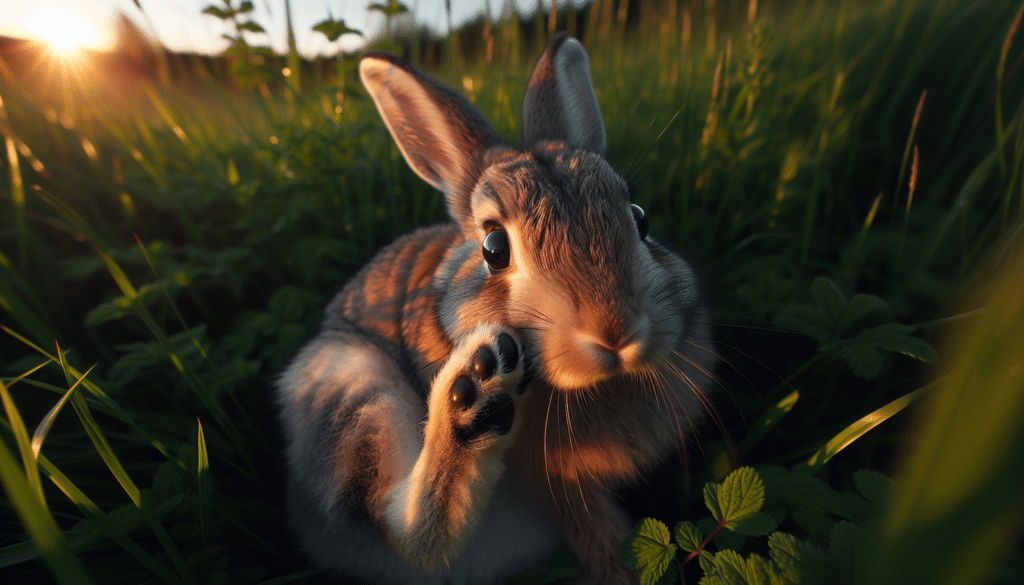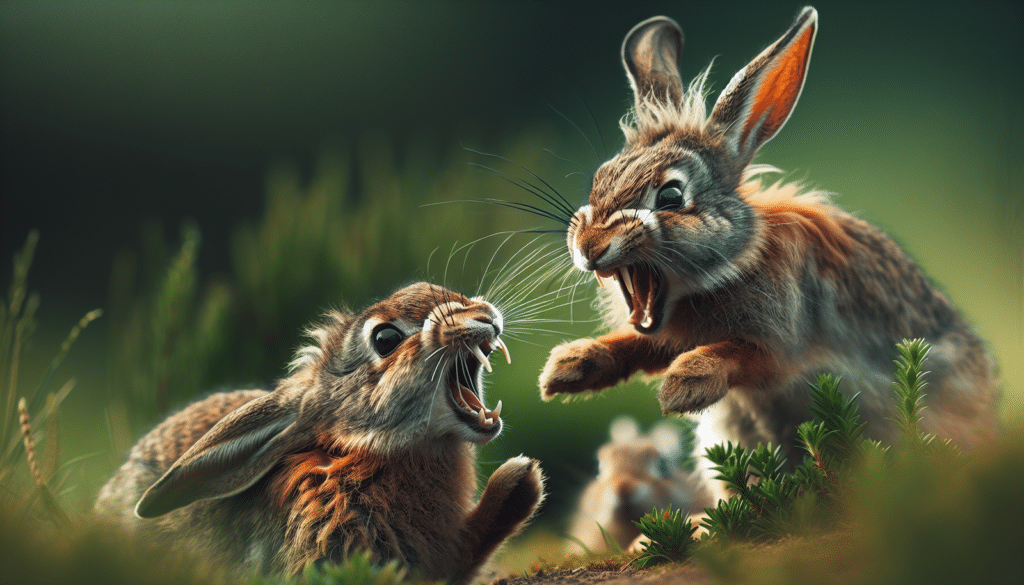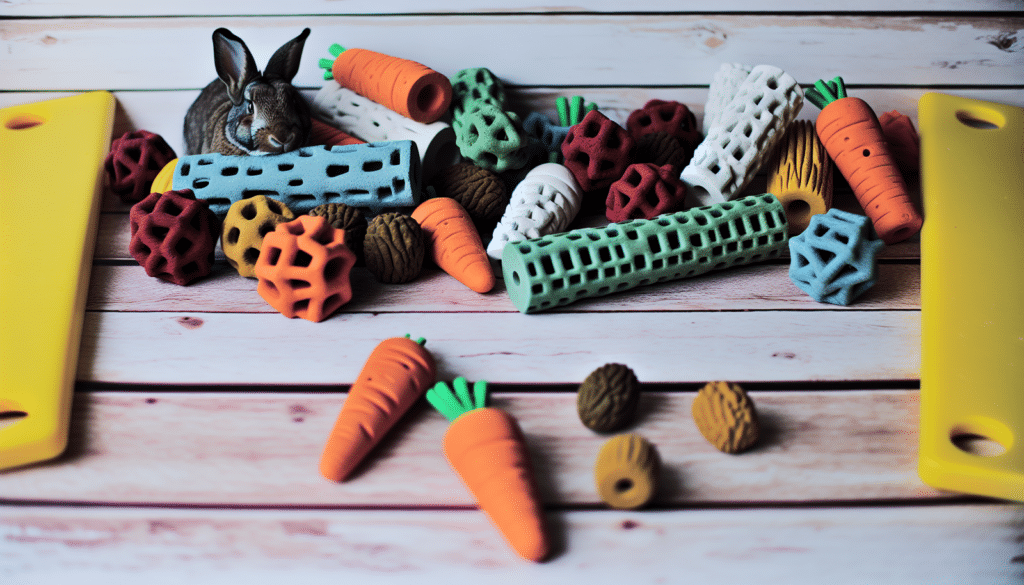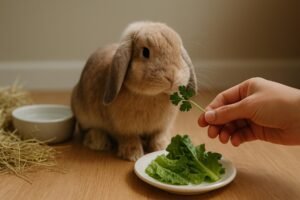When rabbits act out of character, it may be a cry for help. Sudden lethargy, over-grooming, or litter box issues are just a few examples of abnormal behavior in rabbits that can indicate your rabbit is suffering. Understanding these signs is vital in deciphering your pet’s silent communication. This article delves into typical abnormal behaviors you might observe, their underlying causes, and immediate actions you can take to address them, paving the way for further detailed insights without overwhelming you at the onset.
Key Takeaways
Sudden changes in a rabbit’s behavior, such as increased aggression, altered grooming habits, or changes in eating or litter box habits, might indicate stress, environmental discomfort, or underlying health issues that require attention.
Environmental and social management plays a crucial role in preventing and addressing abnormal behavior in rabbits, with strategies including providing a secure environment, avoiding sudden loud noises, gradual introduction to new experiences, and ensuring adequate space and mental stimulation.
Hormonal fluctuations in rabbits can lead to significant changes in behavior, and interventions like spaying or neutering are beneficial in reducing aggressive tendencies and improving overall behavior and group dynamics.
Understanding Abnormal Rabbit Behaviour

Rabbits, much like humans, have a wide range of behaviors that they display in their daily lives. These behaviors can tell us a lot about their mood, health, and overall well-being. However, it’s vital to differentiate between normal and abnormal behavior. Unlike their wild counterparts, domestic rabbits, such as pet rabbits, are in constant contact with humans, and their rabbit behavior is often more complex due to their changing environments.
Understanding natural rabbit behaviors is key to preventing or treating behavioral issues. This understanding also helps in fostering a more harmonious relationship between rabbit owners and their pets. Keeping a close eye on these behaviors is important since sudden changes might signal severe problems requiring medical attention. Failure to address these behavior problems can lead to lower satisfaction levels among owners, increasing the risk of relinquishment to animal shelters.
Identifying Abnormal Behaviours
Every rabbit owner should be competent at pinpointing abnormal behaviors in rabbits. Signs of stress and anxiety can manifest as a hunched posture with flattened ears, hiding, heavy breathing, and frequent attempts to escape their environment. Changes in grooming habits, such as over-grooming or lack of grooming, may indicate stress or underlying health concerns.
Psychological distress or discomfort can also lead to repetitive behaviors without purpose, excessive watchfulness, and uncharacteristic aggression, including biting when handling. Observing your rabbit’s behavior for lethargy, lack of interest in surroundings or food, restlessness, or altered feeding or toileting habits can help detect underlying health issues.
Common Causes of Behavioural Changes
A variety of factors can provoke behavioral changes in rabbits. Some common factors include:
Insufficient exercise
Poor living conditions that prevent rabbits from escaping stressors
Inadequate lighting or inappropriate temperature
Lack of space or poor ventilation
The presence of predators or other perceived threats
These factors can lead to stress-related behaviors and subsequent behavioral changes in rabbits.
Pain, discomfort, or illness can also lead to changes in rabbit behavior. Similarly, rabbits sensitive to temperature changes may exhibit abnormal behaviors, such as hiding, to find more comfortable conditions when it’s too hot or cold. Stress and anxiety can manifest in rabbits as abnormal behaviors, which may arise from:
environmental changes
the introduction of new pets
handling by strangers
unfamiliar experiences like car trips
These can be significant sources of stress for pet rabbits, especially considering the time rabbits spend in such situations.
Providing a stable environment and avoiding fear-inducing stimuli and social stressors are crucial to shield rabbits from stress. Lack of environmental security and stimulation can trigger abnormal behavior in rabbits.
To prevent stress and fear in rabbits, follow these guidelines:
Provide a stable and secure environment
Avoid sudden loud noises or movements
Introduce new objects gradually and observe their reactions
Provide plenty of hiding places and safe spaces
Avoid overcrowding and ensure enough space for each rabbit
Provide mental stimulation through toys and activities
By following these guidelines, you can help create a stress-free environment for your rabbits.
Wild rabbits, as a common prey species, may hide and display other abnormal behaviors when feeling threatened by loud noises or unfamiliar animals.
When to Seek Veterinary Care
Although environmental factors can cause some behavioral changes, others might signify severe health issues necessitating immediate veterinary attention. Rabbits showing signs of discomfort or pain such as loud teeth chattering, being hunched up, lying down stiffly, or being off their food need immediate veterinary care. Significant behavioral changes such as persistent fur pulling, ongoing problems, increased hiding without an obvious cause, or uncertainty about the rabbit’s behavior also warrant veterinary assistance.
Particularly, owners should closely monitor their rabbits for signs of pica, which involves eating non-food items, and seek veterinary attention if such behavior is observed. Unusual signs of stress such as unexpected aggression or altered feeding habits also warrant contacting a vet for further guidance.
Dissecting Aggressive Behaviour in Rabbits

Many rabbit owners find aggression in rabbits troubling. It’s important to realize that rabbit aggression is typically behavioral rather than genetic, and with the right intervention and understanding, it can be modified. An aggressive rabbit can be difficult to handle and may pose a risk to other rabbits or pets in the household.
However, with a good understanding of why this behavior occurs and how to manage it, rabbit owners can help their pets live harmoniously with others, ensuring animal welfare.
Types of Aggression
To effectively manage this behavior, the first step is to understand the types of aggression in rabbits. Territorial aggression includes behaviors such as biting or lunging when their personal space is invaded, like when a hand reaches into their cage. Fear-induced aggression manifests as defensive behaviors like lunging or biting, often in response to perceived threats such as a hand approaching the rabbit’s face.
Hormonal aggression can be observed through the following behaviors in rabbits:
Territorial marking
Urine spraying
Nipping to communicate annoyance or demand space, especially if disturbed during sensitive times such as eating
Extreme cases of aggression, such as chasing or growling at humans, can arise from past negative experiences or significant environmental changes.
Prevention and Management Strategies
A multi-pronged strategy that blends understanding rabbit behavior with cautious handling and environmental management is required to prevent and manage aggression in rabbits. To prevent aggression, avoid reaching into a rabbit’s cage to pull them out, provide ample room with hiding places for security, and approach them gradually and calmly to avoid inducing fear. Early socialization, including gentle handling, allowing them to approach humans willingly for treats, and secure holding practices that make them feel secure, can also prevent aggression.
Managing food-related aggression involves:
Establishing regular and predictable feeding schedules
Providing plenty of hay
Avoiding excitement or uncertainty during feeding
Employing protective clothing to stay calm during interactions
Respecting the rabbit’s body language
Offering them choice and independence
These strategies can help reduce episodes of aggression.
Dealing with Human-Directed Aggression
Managing human-directed aggression in rabbits can be notably challenging. Lunging and nipping in rabbits can be defensive reactions due to poor near-distance vision or as a way of communication when they want space, and these actions are often misinterpreted as aggression. Stress from events like rehoming or insufficient human interaction can cause aggression in rabbits, necessitating patience and positive reinforcement to alleviate.
Here are some tips for managing aggression in rabbits:
Avoid physical punishment, as it can exacerbate aggression and undermine the rabbit-owner trust relationship.
Provide a safe and comfortable environment for your rabbit, with plenty of hiding spots and enrichment.
Gradually introduce your rabbit to new people and situations, using positive reinforcement to reward calm behavior.
Consult with a veterinarian or animal behaviorist for additional guidance and support.
By following these tips, you can help manage and reduce aggression in your rabbit.
To desensitize aggressive rabbits, you can try the following techniques:
Spend time stroking from the top of the head back and securely hold them against your chest to convey peace and security.
Desensitization of inadequately socialized rabbits or those with negative human experiences involves progressive exposure to human presence without invoking fear.
Gentle restraint can be used when a rabbit charges over possessive aggression.
The Mystery of Pica: Unusual Eating Habits in Rabbits

One of the more perplexing behaviors exhibited by some rabbits is pica, a condition characterized by the ingestion of non-food items. Pica can be a serious issue as ingesting these non-food items can lead to severe health problems for rabbits. If pica in rabbits goes untreated, it can result in death, emphasizing the importance of prompt treatment.
In this section, we will delve deeper into this unusual eating habit, its recognition, potential health risks, and how to address it.
Recognizing Pica in Rabbits
Pica behavior in rabbits is characterized by a compulsion to consume materials that lack nutritional value and are detrimental, a behavior distinct from their normal activities such as chewing and digging. This abnormal behavior can be quite concerning, especially when the ingested materials are toxic or can cause blockages in the digestive system.
Potential Health Risks
Pica in rabbits can bring about multiple health problems. Consuming non-food items can cause gastrointestinal blockages, which can be life-threatening if left untreated. The ingestion of certain materials like plastic or fabric can also cause intestinal impactions, leading to severe discomfort and potentially fatal complications.
Addressing Pica Behaviour
A two-pronged strategy is required to address pica behavior in rabbits: restricting access to harmful items and offering mental stimulation. Preventing pica involves removing access to harmful non-food items such as wires, fabric, plastic, and certain kinds of wood. Providing safe, suitable chew toys like toilet roll tubes with hay, branches from safe trees, sterilized pine cones, and sisal rope toys can provide mental stimulation and help deter rabbits from chewing on inappropriate objects.
Regularly altering the selection of chew toys can keep rabbits engaged and discourage chewing on inappropriate objects. Boredom or stress can lead to pica behavior in rabbits, emphasizing the need for ample mental stimulation. If a rabbit continues to display pica behavior despite these preventive measures, it’s crucial to seek veterinary attention to rule out underlying health issues.
The Enigma of Litter Box Issues

Much like cats, rabbits can be trained to use a litter box. Nonetheless, alterations in litter box habits might be an early indicator of stress in rabbits. Inconsistent use of the litter box can be an expression of discontent or discomfort with environmental changes. A rabbit that suddenly stops using the litter box despite being previously trained may be signaling a problem.
Litter box avoidance could be a sign of territorial behavior, especially if a new pet is introduced into the home. Due to the potential for serious health concerns or the indication of stress, litter box issues should be closely monitored and addressed promptly.
Understanding Litter Box Regression
For rabbit owners, litter box regression, a situation where a previously well-trained rabbit suddenly ceases using the litter box, can be especially frustrating. This regression may be due to environmental changes like a new territory or new household members, as well as underlying health problems such as infections or mobility issues.
If a rabbit is digging out litter or going beside the tray, using a covered litter tray or placing the current tray in a cardboard box with an entrance hole may resolve this issue.
Solutions for Litter Box Problems
To address litter box issues in rabbits, a mix of retraining and modifications to their living environment is required. Taking advantage of rabbits’ natural tendency to return to the same place to eliminate can help in retraining them to use the litter box. This behavior can be used to encourage them to use a specific spot for elimination. Assessing the litter box size, location, and access to hay while inside it can also aid in this process. Additionally, regularly cleaning the litter box and placing any droppings or urine found outside back into it reinforces good litter habits.
Providing multiple litter boxes may be necessary for rabbits with larger living spaces or multiple habitat levels. Territorial rabbits may benefit from placing a litter box on furniture they mark, with the use of positive reinforcement when they use it correctly. Consideration should be given to arthritic, senior, and disabled rabbits by providing litter boxes with low entry points.
Neutering and spaying are pivotal for rabbits, not only for managing behavioral issues but also as a crucial aspect of responsible rabbit care. Altered rabbits are generally:
friendlier
more affectionate
have an easier time being trained to use a litter box
less prone to problematic behaviors such as urine marking.
Health-Related Concerns
Health problems such as bladder infections, kidney stones, or pain, which impede a rabbit’s ability to access the litter tray, can bring about changes in elimination patterns. A sudden change in a rabbit’s litter habits, such as an otherwise well-trained rabbit not using their litter box, warrants a veterinary check-up to rule out medical conditions. Symptoms of urinary tract infections in rabbits can include bloody urine, thick beige or brown-colored urine, urinary incontinence, and frequent but small amounts of urination. Risk factors for urinary tract infections in rabbits include obesity, lack of exercise, cage confinement, diets high in alfalfa-based pellets, and inadequate water intake.
To manage urinary tract health and prevent infections, it is recommended for rabbits to:
Have increased activity levels
Have multiple sources of fresh water
Follow a reduced calcium diet
Have a diet rich in moistened greens and high-quality grass hay like timothy hay.
The Significance of Body Language in Detecting Distress

Rabbits, being highly expressive animals, frequently use their body language, including rabbit’s body language, to convey their emotions. Understanding their body language is crucial in determining their emotional state and potential distress. A common posture for a rabbit expressing fear or submission is to flatten itself onto the ground; however, they will remain tense and ready to flee at a moment’s notice, with their tail in an extended and lowered position.
Recognizing these signs of fear or distress allows rabbit owners to respond appropriately, whether it be providing comfort, a safe space, or seeking veterinary advice if necessary.
Reading the Signs
A keen understanding of their body language is necessary to read signs of distress in rabbits. Here are some signs to look out for:
Rabbits express relaxation by lying on their side or abdomen
They show submission or fear by crouching with ears tightly against their heads
They show alertness by having their ears up and mobile
Vocal communications like growling indicate distress
A rabbit actively looking in a certain direction with ears forward or hiding can signal alertness to danger or the need for space and safety
Behaviors driven by rabbits being prey animals include freezing and escaping underground, which are natural responses to perceived threats. Owners should interpret frequent thumping as an indication of a rabbit feeling threatened or overstimulated and therefore observe these body language cues to better understand and address their pets’ needs.
Responding to Your Rabbit’s Signals
Responding appropriately to a rabbit’s signals is vital to maintaining a healthy, harmonious relationship with your pet. When a rabbit gives the cold shoulder, it’s important for owners to be patient and provide the rabbit with the space it needs until it feels ready to interact again. Owners should create a relaxed and pleasant atmosphere when introducing rabbits to new situations to nurture their curiosity and build confidence, rather than forcing interaction.
If a rabbit continues to appear scared, owners should check the rabbit’s environment for potential disturbances such as unfamiliar sounds, new objects, or unusual scents that may be causing the rabbit distress.
Comparative Analysis with Other Species
Like all animals, rabbits have their unique ways of self-expression. While some behaviors may be similar to those of other pet species, many are unique to rabbits. For example, rabbits perform a ‘binky,’ a jump and twist that indicates happiness, which is not seen in other common pets like cats or dogs.
When rabbits perform a ‘flop,’ where they dramatically flop onto their side or back, it signals a feeling of safety, demonstrating their unique way of expressing contentment and relaxation. Rabbits use chinning (rubbing their chin on objects) to mark territory, which is distinct from the territorial marking behaviors of cats and dogs, such as scratching or urinating.
Unlike dogs, rabbits do not yawn when nervous or uncomfortable, which shows a significant deviation in interpreting body language cues between rabbits and other pet species.
Coping with Hormonal Changes and Their Effects
Similar to humans, hormonal changes in rabbits can shape their behavior. Hormonal fluctuations in both male and female rabbits can lead to significant changes in their behavior, particularly in terms of aggression and territoriality. Behavioral symptoms of hormonal changes in rabbits can include:
Aggressive postures
Biting
Circling
Urine spraying
To effectively manage hormonal behavior, steps such as spaying or neutering can be taken to lessen aggressive tendencies and prevent unwanted pregnancy.
Symptoms of Hormonal Behaviour
Hormonal changes in rabbits, particularly during adolescence and in unspayed or unneutered adults, often lead to increased aggression, which may manifest as circling, mounting, and biting. In response to hormonal triggers, rabbits may exhibit territorial behaviors such as increased hiding, urine marking, and ‘chinning’—rubbing their chin on objects to transfer scent.
The ‘circling’ behavior in rabbits, which is often accompanied by honking sounds, is an indication of excitement and affection and can be a sign of sexual frustration induced by hormonal changes. Hormonal behavior can lead to fur pulling for nest building, which is observed in rabbits experiencing a true or false pregnancy.
Benefits of Neutering/Spaying
Spaying or neutering rabbits provides numerous benefits, particularly when it comes to managing hormonal behavior. Neutering significantly reduces the rabbit’s urge to mark territory, improves litter box habits, and can decrease aggression, promoting more harmonious group living. The removal of reproductive urges through neutering/spaying can facilitate the introduction of rabbits to each other and prevent unwanted litters, allowing for better social dynamics.
Behavioral management may still be required for some dominant behaviors that persist after rabbits have been altered post-sexual maturity. Neutering or spaying rabbits is linked to an increase in life expectancy and healthier well-being, alongside a greatly reduced risk of reproductive cancers such as uterine adenocarcinoma. Following the surgery, hormonal levels may not stabilize immediately, and some time is needed for behavioral changes to manifest completely, often ranging from several weeks to a couple of months.
Neutering and spaying are pivotal for rabbits, not only for managing behavioral issues but also as a crucial aspect of responsible rabbit care.
Managing Behaviour Post-Surgery
Following spaying or neutering, a rabbit’s aggression may reduce, but hormones might take up to a month to balance, necessitating patience when anticipating behavioral changes. Rabbits altered after reaching sexual maturity may continue to exhibit certain dominant behaviors that can persist and may require additional behavioral management.
Monitoring the rabbit’s health for signs of discomfort or complications post-surgery is critical. Here are some important steps to follow during the recovery period, typically seven to ten days:
Conduct twice daily checks of the incision site for redness and swelling.
Keep the rabbit in a quiet environment with restricted activity to ensure proper healing.
Administer the prescribed pain medication as directed.
Avoid giving over-the-counter pain medications.
After surgery, it is important to take certain precautions to ensure the rabbit’s recovery goes smoothly. Here are some tips to follow:
An Elizabethan collar might be necessary to keep the rabbit from licking or chewing at the incision site, which can otherwise lead to complications.
Incisions usually have dissolvable sutures and should not be cleaned or have any topical ointment applied to them.
Post-surgery, rabbits may initially reject pellets or hay but will usually consume vegetables and herbs; it is essential to ensure they continue eating normally.
Female rabbits, who undergo a more invasive surgery than male rabbits, may show an increased need for solitude, avoiding handling for several days after their procedure. This is particularly important to consider when dealing with rabbit kittens, as they may be more sensitive to stress.
The Role of Social Structure in Rabbit Behaviour
Similar to many social animals, rabbits have a hierarchy within their group. In a group of rabbits, a social hierarchy is established with some rabbits emerging as dominant, which influences their interactions and behaviors. Rabbits instinctively engage in behaviors such as mounting, grooming, and resource guarding to size each other up and establish dominance, which maintains the social hierarchy and peace within the group.
Dominant European rabbit displays behaviors like:
chasing
nipping
circling other rabbits
mounting
fur pulling
These behaviors are used to assert dominance within their social structure. Dominance can also be observed through grooming behaviors, where a dominant rabbit may groom subordinates less and demand grooming from them and even from their human caretakers.
Importance of Companionship
Being naturally social creatures, rabbits typically live in groups or pairs in the wild. This companionship is crucial for their comfort, and safety, and to prevent them from becoming bored. A rabbit’s desire for the company of other rabbits is as significant as its craving for food, emphasizing the critical nature of social interactions in their well-being. The dynamics of companionship among rabbits are influenced by their social hierarchy where dominant rabbits are more likely to initiate social interactions and subordinate individuals follow.
During the spring, the relationships between bonded rabbit pairs can be tested with increased disagreements and tiffs, likely stemming from heightened hormone levels during the season.
Introducing New Rabbits
To avoid territorial aggression, unfamiliar rabbits should be introduced in a neutral territory that none of the rabbits have claimed, and distractions like hay or tunnels should be provided to alleviate tension. Close observation of new rabbits during introductions is required to help integrate them into existing social structures without disruption and understanding dominant behaviors is key; once bonded, rabbits should not be separated to avoid harming their established connection.
To minimize competition and territorial disputes, provide duplicate resources like separate food bowls and litter trays for the rabbits during the introduction process. In case of serious fighting among rabbits, particularly bonded pairs, temporary separation, and cautious reintroduction may be necessary after their hormonal levels have stabilized.
Observing Natural Social Interactions
Comprehending the social hierarchy among rabbits is crucial as it influences interactions, potentially causing some rabbits to be marginalized or bullied if they are low in the pecking order. Observing rabbit interactions during introductions can shed light on individual personalities and reveal how social bonds may evolve between them. Signs of positive social interactions include:
rabbits ignoring each other at first
self-grooming
engaging in mutual grooming
resting together
sharing food without tension
When rabbits choose to groom one another and lie close, it reflects trust and companionship, signaling successful bonding between them. A successful bonding is often characterized by mutual grooming and resting together, whereas aggressive movements or causing injuries to each other are red flags that require attention.
Summary
Rabbits are complex creatures with unique behaviors that make them fascinating pets. Understanding their behaviors, from recognizing abnormal actions to managing aggressive tendencies and unusual eating habits, is crucial for their well-being and our enjoyment as rabbit owners. It’s also important to understand the impact of hormonal changes on their behavior, the significance of their body language in detecting distress, and the role of social structure in their lives. By observing, understanding, and responding to their behaviors appropriately, we can ensure a happy, healthy, and harmonious relationship with our furry friends.
Frequently Asked Questions
Why has my rabbit’s behavior changed suddenly?
If your rabbit’s behavior has suddenly changed, it could be a sign of distress, illness, or injury, so it’s best to seek advice from a vet or qualified animal behaviorist. Take action to ensure your rabbit’s well-being.
What are the mental issues with rabbits?
Rabbits can develop mental issues such as depression, self-harming behaviors, and aggression if they lack a stimulating environment, appropriate company, and exercise. It’s important to ensure they have a stimulating and enriching environment to prevent these issues.
What is pica in rabbits?
Pica in rabbits is a condition where they ingest non-food items, which can lead to severe health problems and even death due to gastrointestinal blockages.
How can I prevent aggression in my rabbit?
To prevent aggression in your rabbit, avoid reaching into their cage and provide ample room with hiding places for security. Early socialization and gentle handling, along with allowing them to approach humans willingly for treats, can also help prevent aggression.
What are some signs of stress in rabbits?
Some signs of stress in rabbits include a hunched posture with flattened ears, hiding, heavy breathing, frequent attempts to escape their environment, and changes in grooming habits like over-grooming or lack of grooming. Be attentive if you notice these behaviors in your rabbit.



